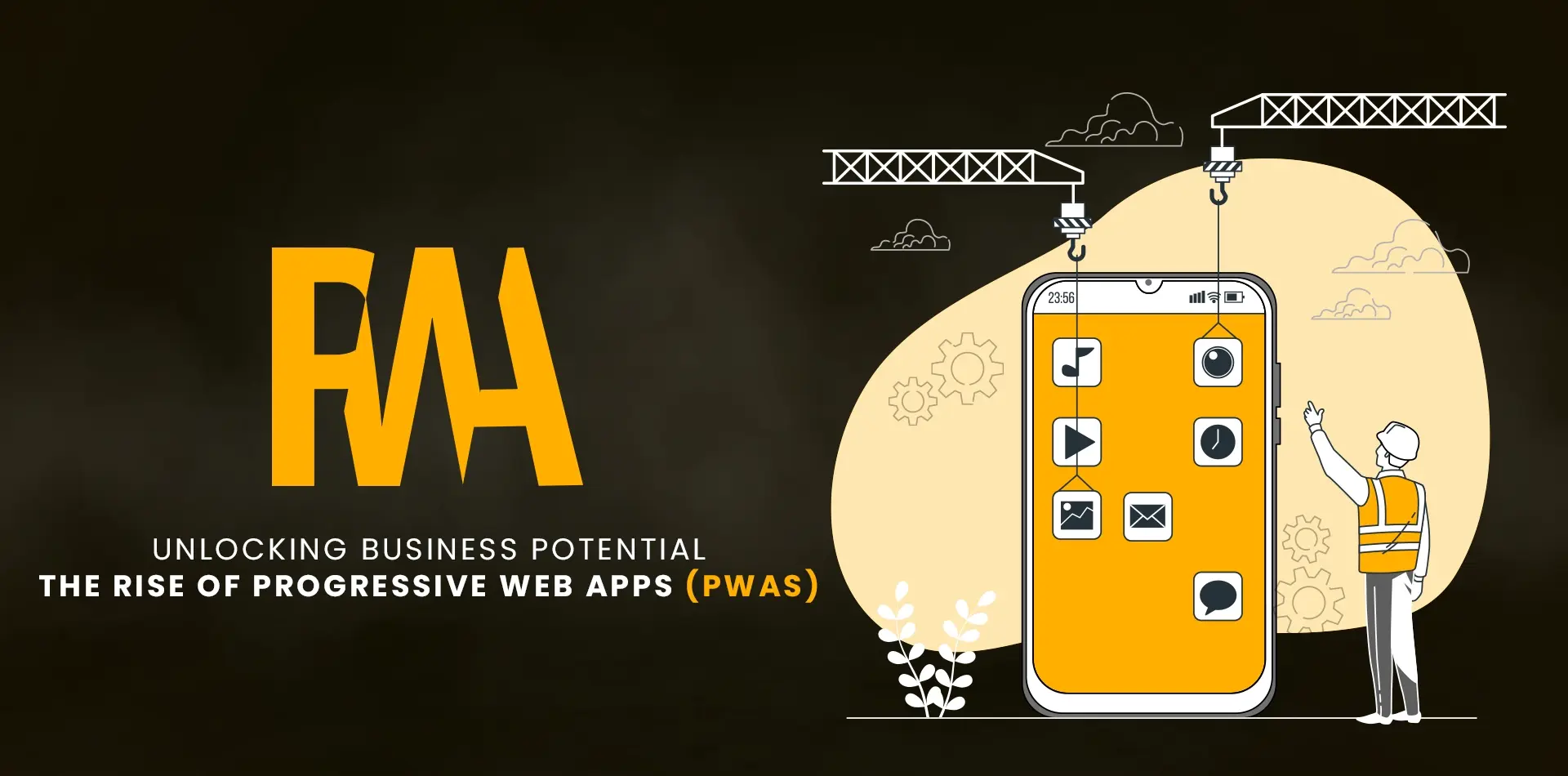Progressive Web Apps (PWAs) are web applications that leverage modern web technologies to deliver an app-like experience to users. Unlike traditional web apps, PWAs offer features such as offline functionality, push notifications, and device hardware access, typically associated with native mobile apps. PWAs are built using web technologies like HTML, CSS, and JavaScript, and they are designed to be responsive, fast, and reliable across various devices and network conditions.
Key Features of Progressive Web Apps and How They Differ from Traditional Web Apps
PWAs possess several key features that set them apart from traditional web apps:
Offline Functionality:
One of the most significant advantages of PWAs is their ability to work offline or with a poor internet connection. This is achieved through the use of service workers, which cache app content and enable offline access to previously visited pages.
Responsive Design:
PWAs are designed to be responsive, ensuring a consistent user experience across different devices and screen sizes. This adaptability is crucial in today’s multi-device landscape, where users expect seamless transitions between desktop and mobile environments.
App-like Interactions:
PWAs mimic the look and feel of native mobile apps, providing users with familiar gestures and interactions. This includes features such as smooth animations, immersive full-screen mode, and the ability to add shortcuts to the home screen.
Push Notifications:
PWAs can send push notifications to users, keeping them informed about important updates, promotions, or events. This helps businesses stay connected with their audience and drive re-engagement with the app.
The Advantages of PWAs for Businesses: Enhanced User Experience and Engagement
PWAs offer several compelling benefits for businesses looking to improve their online presence and engage with their audience more effectively:
Improved Performance:
PWAs are designed to load quickly and provide a smooth user experience, even on low-end devices and slow networks. This improved performance can lead to higher user satisfaction and lower bounce rates.
Increased Reach:
Since PWAs are web-based, they are accessible via a URL and do not require installation from an app store. This lowers the barrier to entry for users and expands the potential reach of the app.
Lower Development Costs:
Building a PWA requires less time and resources compared to developing separate apps for different platforms (e.g., iOS and Android). This can result in significant cost savings for businesses, especially small and medium-sized enterprises (SMEs).
Enhanced Discoverability:
PWAs are indexable by search engines, making them more discoverable to users searching for relevant content or services. This can help businesses attract organic traffic and increase their visibility online.
Accessibility and Reach: How PWAs Bridge the Gap Between Web and Native Apps
One of the key advantages of PWAs is their ability to bridge the gap between web and native apps, offering the best of both worlds to users and businesses alike:
Cross-Platform Compatibility:
PWAs are compatible with various platforms and devices, including desktops, smartphones, and tablets. This cross-platform compatibility ensures a consistent user experience across different environments.
Seamless Updates:
Unlike native apps, which require users to manually update them through an app store, PWAs are automatically updated in the background. This ensures that users always have access to the latest features and improvements without any hassle.
Reduced Friction:
PWAs eliminate the need for users to download and install an app from an app store, reducing friction in the onboarding process. This can lead to higher conversion rates and increased user engagement.
Performance Benefits of PWAs: Faster Loading Times and Offline Functionality
PWAs are designed to deliver a fast and reliable user experience, even in challenging network conditions:
Service Workers:
PWAs leverage service workers to cache app content and assets, enabling them to load quickly and function offline. This improves performance and reduces the reliance on a stable internet connection.
Optimized Resources:
PWAs are optimized for performance, with smaller file sizes and reduced network requests compared to traditional web apps. This optimization results in faster loading times and a smoother user experience.
Background Sync:
PWAs can synchronize data in the background, allowing users to access content even when they are offline or experiencing network interruptions. This ensures that users can continue to interact with the app seamlessly, regardless of their connectivity status.
Cost-Effectiveness:
Why PWAs Are a Viable Option for Businesses of All Sizes
One of the most significant advantages of PWAs is their cost-effectiveness, particularly for businesses with limited resources:
Single Codebase:
PWAs are built using web technologies like HTML, CSS, and JavaScript, allowing businesses to maintain a single codebase for all platforms. This simplifies the development process and reduces overhead costs associated with managing multiple codebases.
No App Store Fees:
Unlike native apps, which are subject to app store fees and revenue-sharing agreements, PWAs can be distributed directly through the web. This eliminates the need to pay commissions to app stores and allows businesses to retain full control over their revenue streams.
Faster Time to Market:
The streamlined development process of PWAs enables businesses to bring their apps to market more quickly, reducing time-to-market and accelerating the return on investment (ROI). This agility is particularly valuable in fast-paced industries where speed is of the essence.
SEO Benefits of PWAs: Improving Search Rankings and Visibility
PWAs offer several SEO benefits that can help businesses improve their search rankings and visibility online:
Improved Performance:
PWAs are optimized for performance, with faster loading times and smoother user experiences. This can lead to lower bounce rates and higher engagement metrics, which are factors considered by search engines when ranking websites.
Mobile-Friendly Design:
PWAs are designed to be responsive, ensuring a consistent user experience across different devices and screen sizes. This mobile-friendly design is essential for SEO, as search engines prioritize mobile-friendly websites in their rankings.
Indexability:
PWAs are indexable by search engines, allowing them to be crawled and indexed like traditional websites. This means that content within PWAs can be discovered by users searching for relevant keywords, driving organic traffic to the app.
Case Studies:
Successful Implementations of PWAs in Various Industries
Numerous businesses across various industries have successfully implemented PWAs to enhance their online presence and engage with their audience more effectively:
Flipkart:
The Indian e-commerce giant Flipkart launched a PWA to improve the shopping experience for its users. The PWA resulted in a 70% increase in conversions, a 40% higher re-engagement rate, and a 3x reduction in data usage compared to the native app.
Twitter:
Twitter rebuilt its mobile website as a PWA to deliver a faster and more reliable experience to its users. The PWA resulted in a 65% increase in pages per session, a 75% increase in tweets sent, and a 20% decrease in bounce rate.
Forbes:
Forbes launched a PWA to improve the performance and accessibility of its website across devices. The PWA resulted in a 43% increase in sessions per user, a 100% increase in engagement, and a 20% increase in ad viewability.
These case studies highlight the tangible benefits that PWAs can deliver to businesses, including increased conversions, engagement, and user satisfaction.
Overcoming Challenges:
Addressing Common Concerns and Misconceptions About PWAs
While PWAs offer numerous advantages, there are also challenges and misconceptions that businesses may encounter:
Browser Support:
While most modern browsers support PWAs, there may be compatibility issues with older or less popular browsers. Businesses should ensure that their PWAs are optimized for the browsers used by their target audience to maximize reach and accessibility.
Limited Native Functionality:
While PWAs offer many features traditionally associated with native apps, they may not fully replicate the functionality of native apps, particularly for resource-intensive tasks or hardware-dependent operations. Businesses should carefully evaluate their requirements and prioritize features accordingly when building a PWA.
App Store Presence:
Since PWAs are distributed directly through the web and do not require installation from an app store, businesses may face challenges in promoting and distributing their PWAs to users. However, strategies such as app banners, social media promotion, and search engine optimization can help businesses overcome this challenge and drive adoption of their PWAs.
Future Trends:
The Growing Adoption of PWAs and What It Means for the Future of App Development
As the adoption of PWAs continues to grow, several trends are shaping the future of app development:
Convergence of Web and Native Technologies:
The lines between web and native technologies are blurring, with PWAs incorporating native-like features and native apps adopting web technologies. This convergence is driving innovation and enabling businesses to deliver more immersive and engaging experiences to their users.
Emergence of Headless CMS:
Headless content management systems (CMS) are becoming increasingly popular, enabling businesses to create and manage content independently of the presentation layer. This flexibility is well-suited for PWAs, which can consume content from various sources and deliver it seamlessly to users.
Focus on Performance and Accessibility:
As users’ expectations for speed, reliability, and accessibility continue to rise, businesses are placing greater emphasis on optimizing the performance and accessibility of their PWAs. This includes minimizing load times, improving user interface (UI) responsiveness, and ensuring compatibility with assistive technologies.
In conclusion, Progressive Web Apps (PWAs) are revolutionizing the way businesses engage with their audience online, offering a compelling alternative to traditional web and native apps. With their enhanced performance, cross-platform compatibility, and cost-effectiveness, PWAs are empowering businesses of all sizes to unlock new opportunities and deliver exceptional user experiences. As the adoption of PWAs continues to grow, businesses must stay ahead of the curve and leverage this transformative technology to drive growth, innovation, and success in the digital era.





